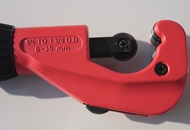A tubing cutter is a basic plumbing tool which resembles a C-clamp, being utilized to cut copper pipe quickly and in the cleanest possible way. As follows, our plumber in London describes in more detail what a tubing cutter is and how it can be used.
Table of Contents
Types of tubing cutters used by our plumbers in London
Tubing cutters can vary in shapes and sizes, depending on the pipe that needs cutting. These basic plumbing tools are utilized mainly to cut copper, therefore the blade is generally too thin to cut an iron or an ABS pipe, except for when the blade is changed.
The tubing cutters used by our emergency plumber in London can be:
• Standard cutters: these cut by rotation. They are clamped onto the pipe, after which the tubing cutters are turned around the pipe;
• Thumb cutters: these are mostly used by our plumbers in London because they can fit into small spaces. They function pretty much the same as the standard tubing cutters, but they are tightened with the thumb each turn or two until they cut the pipe;
• Auto cutters: they are fantastic basic plumbing tools which occupy even less space when being used. The auto cutters are clamped onto the pipe and switched into one direction, tightening automatically, until the copper pipe is completely cut.
How our plumber in London uses the tubing cutter
Being used for many different plumbing jobs, a tubing cutter can cut plumbing or gas lines, as well as only a conduit.
It is an important tool in any plumbing professional’s kit, because attempting to cut a tubing without a special piece of equipment can cause crimping the tubing or having an end which is not square.
When utilizing a tubing cutter, our local plumbers follow the steps mentioned below:
• Measuring the length of the needed tube;
• Placing the cutting wheel of the tubing cutter on the tube and tightening the jaws;
• Rotating the cutter around the tube. Then, the screw is tightened approximately ¼ or ½ a turn, and then the tube is rotated again. Every time this is done, the cut becomes a little deeper;
• The procedure is continued until the tubing wall in entirely cut;
• Twisting a drill bit around the tube opening of the tube to clear the edge from the tube. This is also effectuated to eliminate any burrs.
If you are interested to know more about this basic plumbing tool, as well as for help in any plumbing issue, we kindly invite you to contact our local plumbers.

